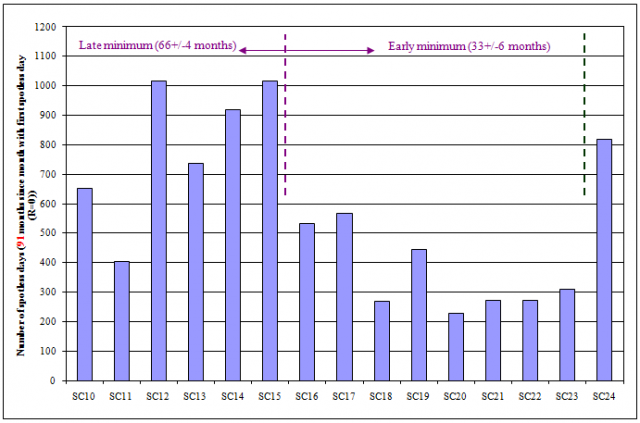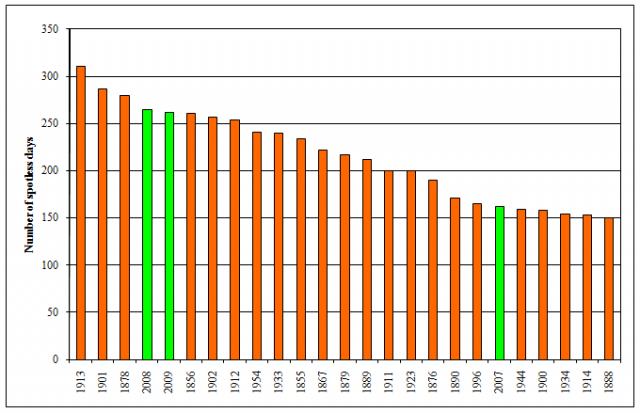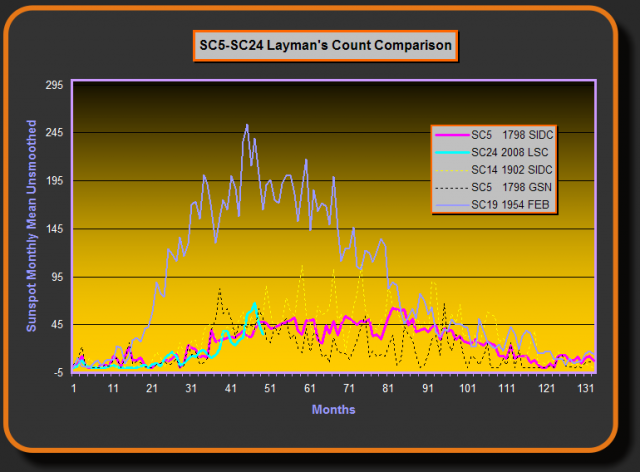D'Aleo-Sunspot Count Down Again in January 13 years ago
Several commenters asked for an update on the latest solar cycle 24 and my ideas about where we are going.For the second straight month, the sunspot number and solar flux declined.
.jpg)
You can see we are three plus years into the new cycle. In many of the recent cycles we peaked around now.

The minimum was long and deep with over 800 spotless days. Three of the years ranked in the top 20 spotless years since 1850.


Most solar scientists recognize our ability to see even small spots is much better with today's technology than was possible even 50 to 100 years ago. More than one group has attempted to track the solar activity in the same way as earlier, counting only spots that would have been counted before.
That would lower the current SSN and increase the number of spotless days in recent years, when often even the smallest "pore's" as spots. One site is here - called the Layman's sunpsot count).
Many solar scientists see similarity to the Dalton minimum - cycle 5. In the Layman's count method, this cycle is tracking well with cycle 5, which was in the Dalton.

Here GSN is an alternative count by Hoyt Schatten a lot like the layman's count. SIDC is the global standard in Belgium which combines data from many global observatories.
The Dalton Minimum was the mini ice age - the age of Dicken's characterized by winter with more cold and snow in Europe. Something we have been seeing in recent years despite predictions in 2000 and as late as 20007 that winter snow was becoming and would increasingly become extremely rare.
.jpg)
At last year's annual American Astronomical Society meeting in NM, three different papers discussed the coming grand minimum. See this story on Space.com.
"The solar cycle may be going into a hiatus," Frank Hill, associate director of the National Solar Observatory's Solar Synoptic Network, said in a news briefing (June 14).
The studies looked at a missing jet stream in the solar interior, fading sunspots on the sun's visible surface, and changes in the corona and near the poles.
"This is highly unusual and unexpected," Hill said. "But the fact that three completely different views of the sun point in the same direction is a powerful indicator that the sunspot cycle may be going into hibernation.
In a second study, researchers tracked a long-term weakening trend in the strength of sunspots, and predict that by the next solar cycle, magnetic fields erupting on the sun will soon be so weak that few, if any, sunspots will be formed.
With more than 13 years of sunspot data collected at the McMath-Pierce Telescope at Kitt Peak in Arizona, Matt Penn and William Livingston observed that the average magnetic field strength declined significantly during Cycle 23 and now into Cycle 24. Consequently, sunspot temperatures have risen, they observed.
If the trend continues, the sun's magnetic field strength will drop below a certain threshold and sunspots will largely disappear; the field no longer will be strong enough to overcome such convective forces on the solar surface. They estimate that could be around 2014 or 2015.
Despite all the news about the major Coronal Mass Ejection and auroras in January, the magnetic indices for the month remain at amazingly low levels as they have continuously since 2006.

Notice how in recent months the trend in activity has been slightly down. The Ap (blue) during the stormy period averaged only 25. In major eruptions in the last decade, it reached well over 100.
.gif)
As for when the maximum will be reached - estimates vary from late 2012 to 2014 or even later (most late have have a long plateau top) with estimates of maxima mainly between 70 and 90 (today's counting). The last cycle peaked at 120.
The cycle peak will be announced when the magnetic fields of the two solar hemispheres flip. The latest count (not sure when last updated) from the Wilcox Solar Observatory has it close but perhaps up to a year away. the sign of the southern solar polar hemisphere's is reversed so it can be seen how they change together better. Note when the fields cross the 0 is the solar maxima - 1980, 1989, 2000, ?.
The longer the cycles, the colder the climate that follows (with a lag of 8 years or more). The last two minima were 12.5 years apart, considerably longer than recent cycles. The minimum in December 2008 would argue for cooling to show itself in a bigger way around 2014 about the time the sun again declines.
My belief is that the decline (not linear) will accelerate as we approach 2020 and that if Livingston and Penn are right, cycle 25 will be a pimple. It will be hard to deny that the sun controls the climate by that time, although attempts will be made to blame the Chinese for burning coal. My guess by that time, the world would ignore these scientists and environmentalists' claim.
On the high mrore conservative end of the possibilities would be cooling like the decades like the 1960s and 1970s as JB has noted.
In a peer reviewed paper I coauthored with Dr. Don Easterbrook, we included this projection.

For more on the sun see this and this. The first papaer was updated, peer reviewed, modifeied accordingly and published in Evidence Based Climate Science, a book by Elsevier, edited by Don Easterbrook. I am an author and co-author on four peer reviewed papers/chapters in that book.